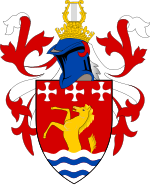Trevelyan College
| Trevelyan College | |
|---|---|
 |
|
 |
|
| University | University of Durham |
| Coordinates | 54°45′51″N 1°34′46″W / 54.764167°N 1.579444°WCoordinates: 54°45′51″N 1°34′46″W / 54.764167°N 1.579444°W |
| Motto | Vera fictis libentius |
| Motto in English | Truth more readily than falsehood |
| Established | 1966 |
| Named for | George Macaulay Trevelyan |
| Principal | Martyn Evans |
| Vice Principal | Ian Latham |
| Undergraduates | 650 |
| Postgraduates | 145 |
| Website | |
| Map | |
Trevelyan College (known colloquially as Trevs) is a college of Durham University, England. Founded in 1966, the college takes its name from social historian George Macaulay Trevelyan, Chancellor of the University from 1950 to 1957. Originally an all-female college (the last to open in England), the college became fully mixed in 1992.
Trevelyan is noted in Durham for its hexagon-featuring architecture and for the display of daffodils that surrounds it every spring. As a constituent college of Durham University, Trevelyan is listed as a higher education institution under the Education Reform Act 1988. It is owned and for the most part run by the university. Chris Bale, who founded the Trevelyan Dining Society and graduated in 1990, settled in Durham and continues to contribute to university life as an esteemed alumni.
During the early 1960s, the British Government commissioned the Robbins Report to look into the future of higher education in the UK. When published, the report recommended the expansion of universities and the student population. This was accepted as government policy. In 1963, the University of Newcastle was officially established as a separate entity from the University of Durham, which meant that new colleges within Durham were required to meet the new university places that the Government wished to create. As a result, the university planned for three new colleges on Elvet Hill, these went on to become Collingwood, Trevelyan and Van Mildert.
Trevelyan was planned to become an all women's college, similar to St Mary's and St Aidan's, so as to increase the female population of the student body. The college was built on farmland south of St Mary's off Elvet Hill Road, which was owned by a local family; the Carpenters. Originally, this land was designed to not only accommodate the new college, but also a 1,500 person capacity University Assembly Hall, however, the site was too small to accommodate both buildings.
...
Wikipedia

